Daniel W.W. Biostatistics: A Foundation for Analysis in the Health Sciences
Подождите немного. Документ загружается.


The three sample regression equations for the three levels of the qualitative variable, then,
are as follows:
Level 1 ( )
(11.2.5)
Level 2 ( )
(11.2.6)
Level 3 ( )
(11.2.7)
Let us illustrate these results by means of an example.
EXAMPLE 11.2.3
A team of mental health researchers wishes to compare three methods (A, B, and C) of
treating severe depression. They would also like to study the relationship between age
and treatment effectiveness as well as the interaction (if any) between age and treatment.
Each member of a simple random sample of 36 patients, comparable with respect to
diagnosis and severity of depression, was randomly assigned to receive treatment A, B,
or C. The results are shown in Table 11.2.2. The dependent variable Y is treatment effec-
tiveness, the quantitative independent variable X
1
is patient’s age at nearest birthday, and
the independent variable type of treatment is a qualitative variable that occurs at three
levels. The following dummy variable coding is used to quantify the qualitative variable:
The scatter diagram for these data is shown in Figure 11.2.4. Table 11.2.3 shows the
data as they were entered into a computer for analysis. Figure 11.2.5 contains the printout
of the analysis using the MINITAB multiple regression program.
Solution: Now let us examine the printout to see what it provides in the way of insight
into the nature of the relationships among the variables. The least-squares
equation is
y
N
j
= 6.21 + 1.03x
1j
+ 41.3x
2j
+ 22.7x
3j
- .703x
1j
x
2j
- .510x
1j
x
3j
X
3
= e
1 for treatment B
0 otherwise
X
2
= e
1 for treatment A
0 otherwise
= b
N
0
+ b
N
1
x
1j
y
N
j
= b
N
0
+ b
N
1
x
1j
+ b
N
2
102+ b
N
3
102+ b
N
4
x
1j
102+ b
N
5
x
1j
102
X
2
0, X
3
0
= 1b
N
0
+ b
N
3
2+ 1b
N
1
+ b
N
5
2x
1j
= b
N
0
+ b
N
1
x
1j
+ b
N
3
+ b
N
5
x
1j
y
N
j
= b
N
0
+ b
N
1
x
1j
+ b
N
2
102+ b
N
3
112+ b
N
4
x
1j
102+ b
N
5
x
1j
112
X
2
0, X
3
1
= 1b
N
0
+ b
N
2
2+ 1b
N
1
+ b
N
4
2x
1j
= b
N
0
+ b
N
1
x
1j
+ b
N
2
+ b
N
4
x
1j
y
N
j
= b
N
0
+ b
N
1
x
1j
+ b
N
2
112+ b
N
3
102+ b
N
4
x
1j
112+ b
N
5
x
1j
102
X
2
1, X
3
0
11.2 QUALITATIVE INDEPENDENT VARIABLES 547
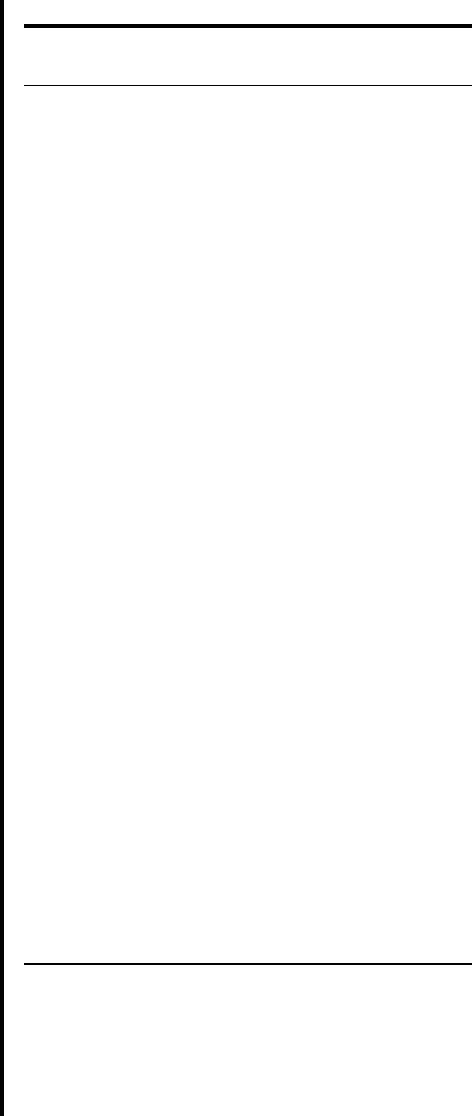
548 CHAPTER 11 REGRESSION ANALYSIS: SOME ADDITIONAL TECHNIQUES
TABLE 11.2.2 Data for Example 11.2.3
Measure of Method of
Effectiveness Age Treatment
56 21 A
41 23 B
40 30 B
28 19 C
55 28 A
25 23 C
46 33 B
71 67 C
48 42 B
63 33 A
52 33 A
62 56 C
50 45 C
45 43 B
58 38 A
46 37 C
58 43 B
34 27 C
65 43 A
55 45 B
57 48 B
59 47 C
64 48 A
61 53 A
62 58 B
36 29 C
69 53 A
47 29 B
73 58 A
64 66 B
60 67 B
62 63 A
71 59 C
62 51 C
70 67 A
71 63 C
The three regression equations for the three treatments are as follows:
Treatment A (Equation 11.2.5)
= 47.51 + .327x
1j
y
N
j
= 16.21 + 41.32+ 11.03 - .7032x
1j
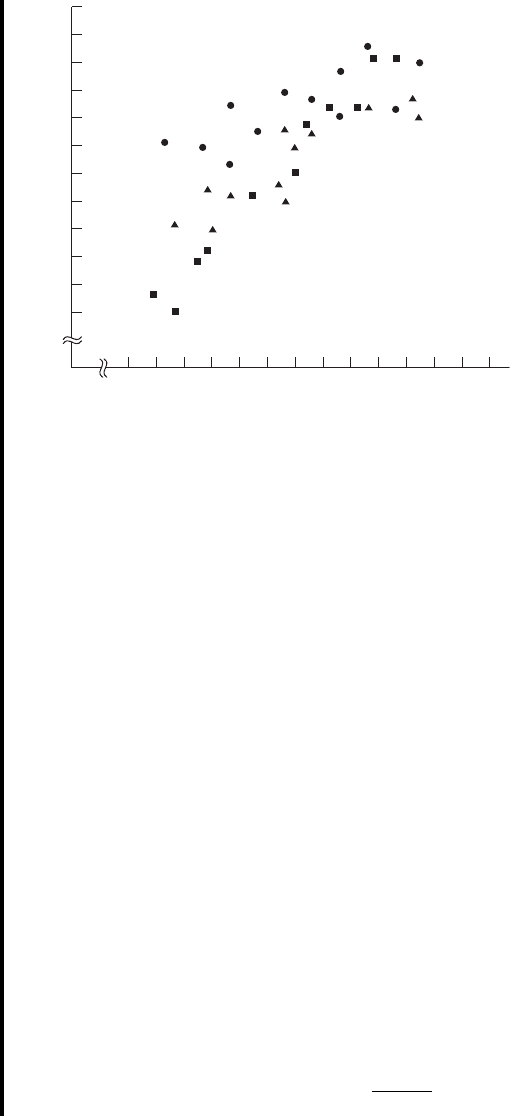
Treatment B (Equation 11.2.6)
Treatment C (Equation 11.2.7)
Figure 11.2.6 contains the scatter diagram of the original data along
with the regression equations for the three treatments. Visual inspection of
Figure 11.2.6 suggests that treatments A and B do not differ greatly with
respect to their slopes, but their y-intercepts are considerably different. The
graph suggests that treatment A is better than treatment B for younger
patients, but the difference is less dramatic with older patients. Treatment C
appears to be decidedly less desirable than both treatments A and B for
younger patients but is about as effective as treatment B for older patients.
These subjective impressions are compatible with the contention that there
is interaction between treatments and age.
Inference Procedures
The relationships we see in Figure 11.2.6, however, are sample results. What can we
conclude about the population from which the sample was drawn?
For an answer let us look at the t ratios on the computer printout in Figure 11.2.5.
Each of these is the test statistic
t =
b
N
i
- 0
s
b
N
i
y
N
j
= 6.21 + 1.03x
1j
= 28.91 + .520x
1j
y
N
j
= 16.21 + 22.72+ 11.03 - .5102x
1j
11.2 QUALITATIVE INDEPENDENT VARIABLES 549
15
80
75
70
65
60
55
50
45
40
35
30
25
20 25 30 35 40 45 50 55 60 65 70 75 80
Age
Treatment effectiveness
FIGURE 11.2.4 Scatter diagram of data for Example 11.2.3:
( ) treatment A, ( ) treatment B, ( ) treatment C.䊏䉱䊉
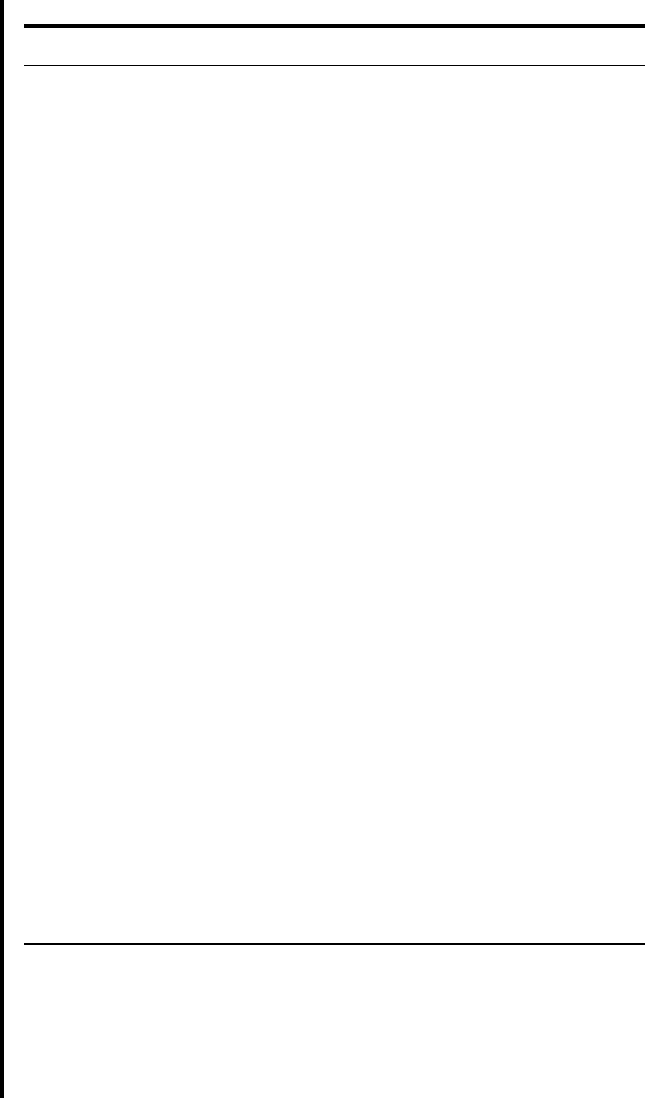
550 CHAPTER 11 REGRESSION ANALYSIS: SOME ADDITIONAL TECHNIQUES
TABLE 11.2.3 Data for Example 11.2.3 Coded for Computer Analysis
Y
56 21 1 0 21 0
55 28 1 0 28 0
63 33 1 0 33 0
52 33 1 0 33 0
58 38 1 0 38 0
65 43 1 0 43 0
64 48 1 0 48 0
61 53 1 0 53 0
69 53 1 0 53 0
73 58 1 0 58 0
62 63 1 0 63 0
70 67 1 0 67 0
41 23 0 1 0 23
40 30 0 1 0 30
46 33 0 1 0 33
48 42 0 1 0 42
45 43 0 1 0 43
58 43 0 1 0 43
55 45 0 1 0 45
57 48 0 1 0 48
62 58 0 1 0 58
47 29 0 1 0 29
64 66 0 1 0 66
60 67 0 1 0 67
28 19 0 0 0 0
25 23 0 0 0 0
71 67 0 0 0 0
62 56 0 0 0 0
50 45 0 0 0 0
46 37 0 0 0 0
34 27 0 0 0 0
59 47 0 0 0 0
36 29 0 0 0 0
71 59 0 0 0 0
62 51 0 0 0 0
71 63 0 0 0 0
X
1
X
3
X
1
X
2
X
3
X
2
X
1
for testing We see by Equation 11.2.5 that the y-intercept of the regression
line for treatment A is equal to Since the t ratio of 8.12 for testing
is greater than the critical t of 2.0423 (for ), we can reject that and
conclude that the y-intercept of the population regression line for treatment A is differ-
ent from the y-intercept of the population regression line for treatment C, which has a
b
2
= 0H
0
a = .05
H
0
: b
2
= 0b
N
0
+ b
N
2
.
H
0
: b
i
= 0.
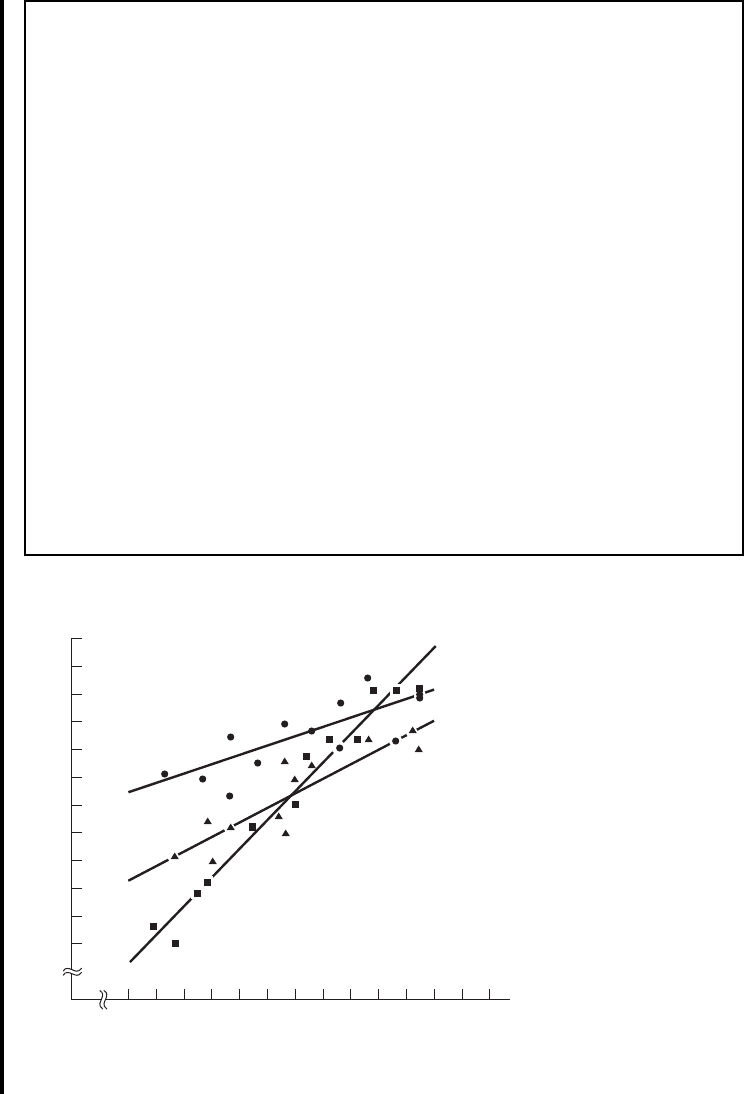
11.2 QUALITATIVE INDEPENDENT VARIABLES 551
The regression equation is
Predictor Coef Stdev t-ratio p
Constant 6.211 3.350 1.85 0.074
x1 1.03339 0.07233 14.29 0.000
x2 41.304 5.085 8.12 0.000
x3 22.707 5.091 4.46 0.000
x4 0.1090 0.000
x5 0.1104 0.000
Analysis of Variance
SOURCE DF SS MS F p
Regression 5 4932.85 986.57 64.04 0.000
Error 30 462.15 15.40
Total 35 5395.00
SOURCE DF SEQ SS
x1 1 3424.43
x2 1 803.80
x3 1 1.19
x4 1 375.00
x5 1 328.42
R-sq1adj2= 90.0%R-sq = 91.4%s = 3.925
-4.62-0.5097
-6.45-0.7029
y = 6.21 + 1.03
x1 + 41.3 x2 + 22.7 x3 - 0.703 x4 - 0.510 x5
FIGURE 11.2.5 Computer printout, MINITAB multiple regression analysis, Example 11.2.3.
15
80
75
70
65
60
55
50
45
40
35
30
25
20 25 30 35 40 45 50 55 60 65 70 75 80
Age
Treatment C
Treatment A
Treatment B
Treatment effectiveness
FIGURE 11.2.6 Scatter diagram of data for Example 11.2.3 with the fitted
regression lines: ( ) treatment A, ( ) treatment B, ( ) treatment C.䊏䉱䊉
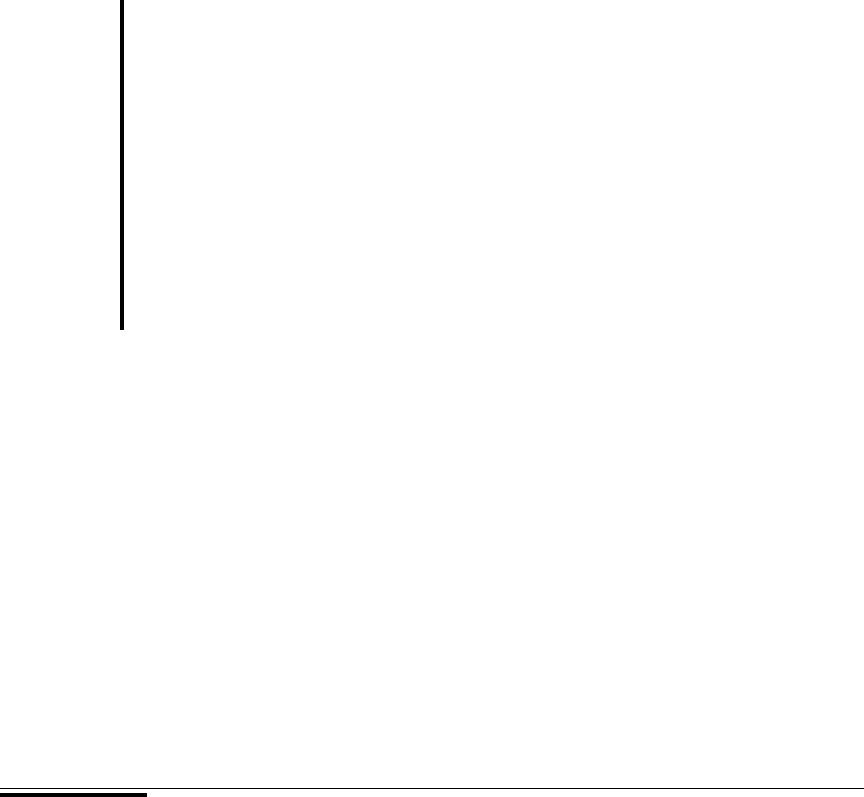
y-intercept of Similarly, since the t ratio of 4.46 for testing is also greater
than the critical t of 2.0423, we can conclude (at the .05 level of significance) that the
y-intercept of the population regression line for treatment B is also different from the y-
intercept of the population regression line for treatment C. (See the y-intercept of Equa-
tion 11.2.6.)
Now let us consider the slopes. We see by Equation 11.2.5 that the slope of the
regression line for treatment A is equal to (the slope of the line for treatment C)
Since the t ratio of for testing is less than the critical t of
we can conclude (for ) that the slopes of the population regression lines for treat-
ments A and C are different. Similarly, since the computed t ratio for testing
is also less than we conclude (for ) that the population regression lines
for treatments B and C have different slopes (see the slope of Equation 11.2.6). Thus we
conclude that there is interaction between age and type of treatment. This is reflected by
a lack of parallelism among the regression lines in Figure 11.2.6. ■
Another question of interest is this: Is the slope of the population regression line
for treatment A different from the slope of the population regression line for treatment
B? To answer this question requires computational techniques beyond the scope of
this text. The interested reader is referred to books devoted specifically to regression
analysis.
In Section 10.4 the reader was warned that there are problems involved in making
multiple inferences from the same sample data. Again, books on regression analysis are
available that may be consulted for procedures to be followed when multiple inferences,
such as those discussed in this section, are desired.
We have discussed only two situations in which the use of dummy variables is
appropriate. More complex models involving the use of one or more qualitative inde-
pendent variables in the presence of two or more quantitative variables may be appro-
priate in certain circumstances. More complex models are discussed in the many books
devoted to the subject of multiple regression analysis.
EXERCISES
For each exercise do the following:
(a) Draw a scatter diagram of the data using different symbols for the different categorical variables.
(b) Use dummy variable coding and regression to analyze the data.
(c) Perform appropriate hypothesis tests and construct appropriate confidence intervals using your
choice of significance and confidence levels.
(d) Find the p value for each test that you perform.
11.2.1 For subjects undergoing stem cell transplants, dendritic cells (DCs) are antigen-presenting cells that
are critical to the generation of immunologic tumor responses. Bolwell et al. (A-2) studied lymphoid
DCs in 44 subjects who underwent autologous stem cell transplantation. The outcome variable is the
concentration of DC2 cells as measured by flow cytometry. One of the independent variables is the
a = .05-2.0423,
H
0
: b
5
= 0
a = .05
-2.0423,H
0
: b
4
= 0-6.45
+ b
N
4
.b
N
1
H
0
: b
3
= 0b
0
.
552 CHAPTER 11 REGRESSION ANALYSIS: SOME ADDITIONAL TECHNIQUES
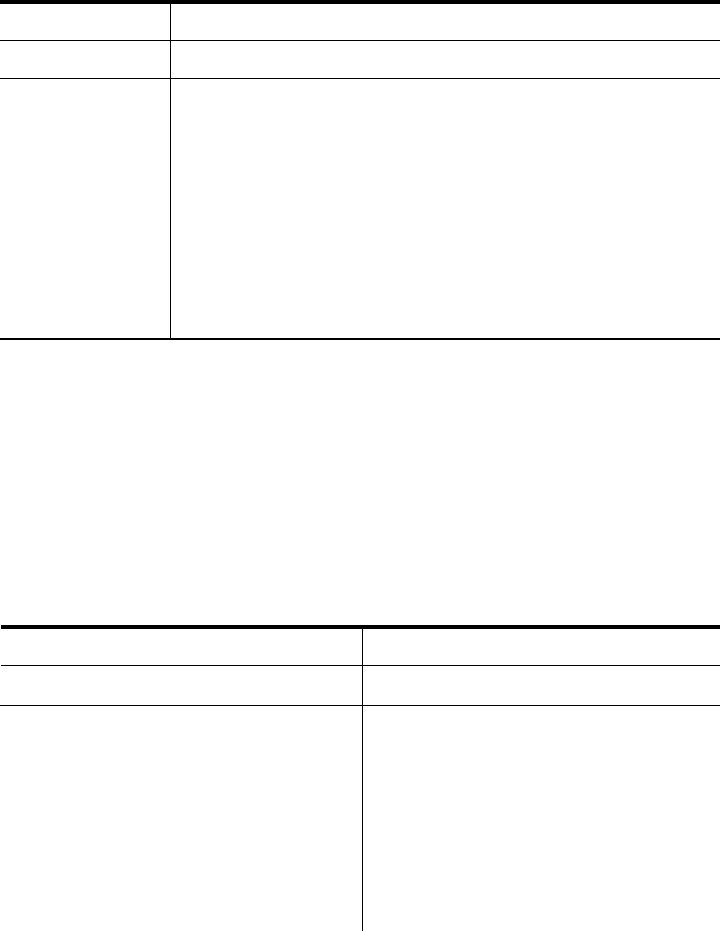
age of the subject (years), and the second independent variable is the mobilization method. During
chemotherapy, 11 subjects received granulocyte colony-stimulating factor (G-CSF) mobilizer
( g/kg/day) and 33 received etoposide (2 ). The mobilizer is a kind of blood progenitor cell
that triggers the formation of the DC cells. The results were as follows:
G-CSF Etoposide
DC Age DC Age DC Age DC Age
6.16 65 3.18 70 4.24 60 4.09 36
6.14 55 2.58 64 4.86 40 2.86 51
5.66 57 1.69 65 4.05 48 2.25 54
8.28 47 2.16 55 5.07 50 0.70 50
2.99 66 3.26 51 4.26 23 0.23 62
8.99 24 1.61 53 11.95 26 1.31 56
4.04 59 6.34 24 1.88 59 1.06 31
6.02 60 2.43 53 6.10 24 3.14 48
10.14 66 2.86 37 0.64 52 1.87 69
27.25 63 7.74 65 2.21 54 8.21 62
8.86 69 11.33 19 6.26 43 1.44 60
Source: Lisa Rybicki, M.S. Used with permission.
11.2.2 According to Pandey et al. (A-3) carcinoma of the gallbladder is not infrequent. One of the pri-
mary risk factors for gallbladder cancer is cholelithiasis, the asymptomatic presence of stones in
the gallbladder. The researchers performed a case-control study of 50 subjects with gallbladder
cancer and 50 subjects with cholelithiasis. Of interest was the concentration of lipid peroxidation
products in gallbladder bile, a condition that may give rise to gallbladder cancer. The lipid perox-
idation product melonaldehyde (MDA, g/mg) was used to measure lipid peroxidation. One of the
independent variables considered was the cytochrome P-450 concentration (CYTO, nmol/mg).
Researchers used disease status (gallbladder cancer vs. cholelithiasis) and cytochrome P-450 con-
centration to predict MDA. The following data were collected.
Cholelithiasis Gallbladder Cancer
MDA CYTO MDA CYTO MDA CYTO MDA CYTO
0.68 12.60 11.62 4.83 1.60 22.74 9.20 8.99
0.16 4.72 2.71 3.25 4.00 4.63 0.69 5.86
0.34 3.08 3.39 7.03 4.50 9.83 10.20 28.32
3.86 5.23 6.10 9.64 0.77 8.03 3.80 4.76
0.98 4.29 1.95 9.02 2.79 9.11 1.90 8.09
3.31 21.46 3.80 7.76 8.78 7.50 2.00 21.05
1.11 10.07 1.72 3.68 2.69 18.05 7.80 20.22
4.46 5.03 9.31 11.56 0.80 3.92 16.10 9.06
1.16 11.60 3.25 10.33 3.43 22.20 0.98 35.07
1.27 9.00 0.62 5.72 2.73 11.68 2.85 29.50
m
g>m
2
m
EXERCISES 553
(Continued)
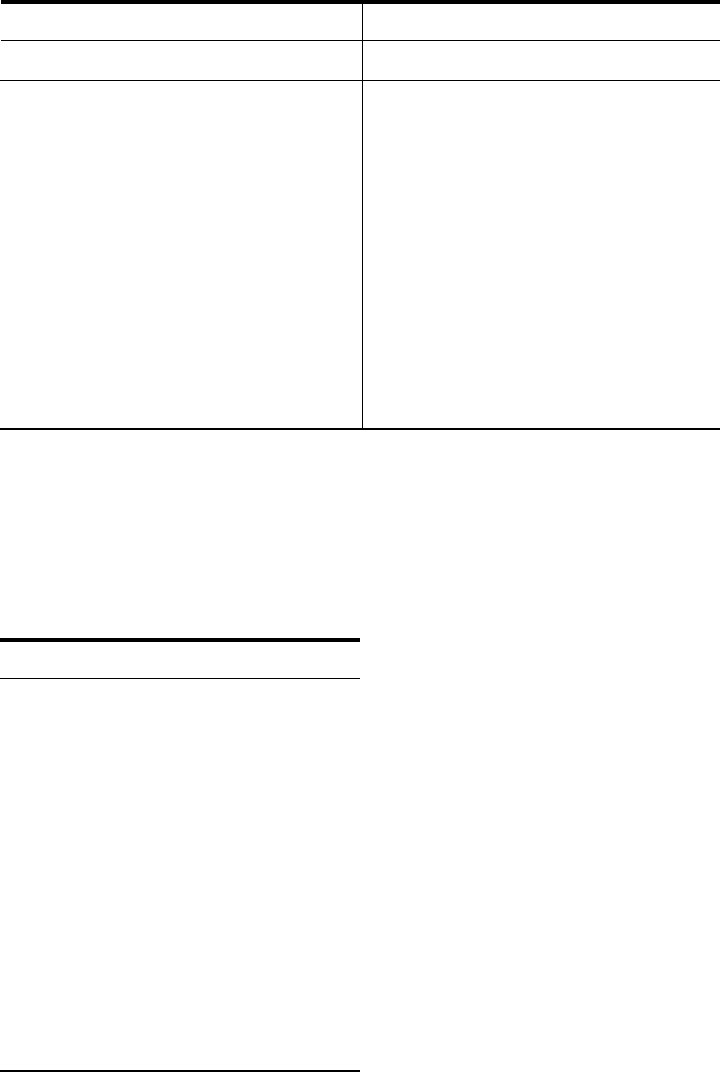
Cholelithiasis Gallbladder Cancer
MDA CYTO MDA CYTO MDA CYTO MDA CYTO
1.38 6.13 2.46 4.01 1.41 19.10 3.50 45.06
3.83 6.06 7.63 6.09 6.08 36.70 4.80 8.99
0.16 6.45 4.60 4.53 5.44 48.30 1.89 48.15
0.56 4.78 12.21 19.01 4.25 4.47 2.90 10.12
1.95 34.76 1.03 9.62 1.76 8.83 0.87 17.98
0.08 15.53 1.25 7.59 8.39 5.49 4.25 37.18
2.17 12.23 2.13 12.33 2.82 3.48 1.43 19.09
0.00 0.93 0.98 5.26 5.03 7.98 6.75 6.05
1.35 3.81 1.53 5.69 7.30 27.04 4.30 17.05
3.22 6.39 3.91 7.72 4.97 16.02 0.59 7.79
1.69 14.15 2.25 7.61 1.11 6.14 5.30 6.78
4.90 5.67 1.67 4.32 13.27 13.31 1.80 16.03
1.33 8.49 5.23 17.79 7.73 10.03 3.50 5.07
0.64 2.27 2.79 15.51 3.69 17.23 4.98 16.60
5.21 12.35 1.43 12.43 9.26 9.29 6.98 19.89
Source: Manoj Pandey, M.D. Used with permission.
11.2.3 The purpose of a study by Krantz et al. (A-4) was to investigate dose-related effects of methadone
in subjects with torsades de pointes, a polymorphic ventricular tachycardia. In the study of 17
subjects, 10 were men ( ) and seven were women ( ). The outcome variable, is the
QTc interval, a measure of arrhythmia risk. The other independent variable, in addition to sex,
was methadone dose (mg/day). Measurements on these variables for the 17 subjects were as
follows.
Sex Dose (mg/day) QTc (msec)
0 1000 600
0 550 625
0 97 560
1 90 585
1 85 590
1 126 500
0 300 700
0 110 570
1 65 540
1 650 785
1 600 765
1 660 611
1 270 600
1 680 625
0 540 650
0 600 635
1 330 522
sex = 1sex = 0
554 CHAPTER 11 REGRESSION ANALYSIS: SOME ADDITIONAL TECHNIQUES
Source: Mori J. Krantz, M.D.
Used with permission.
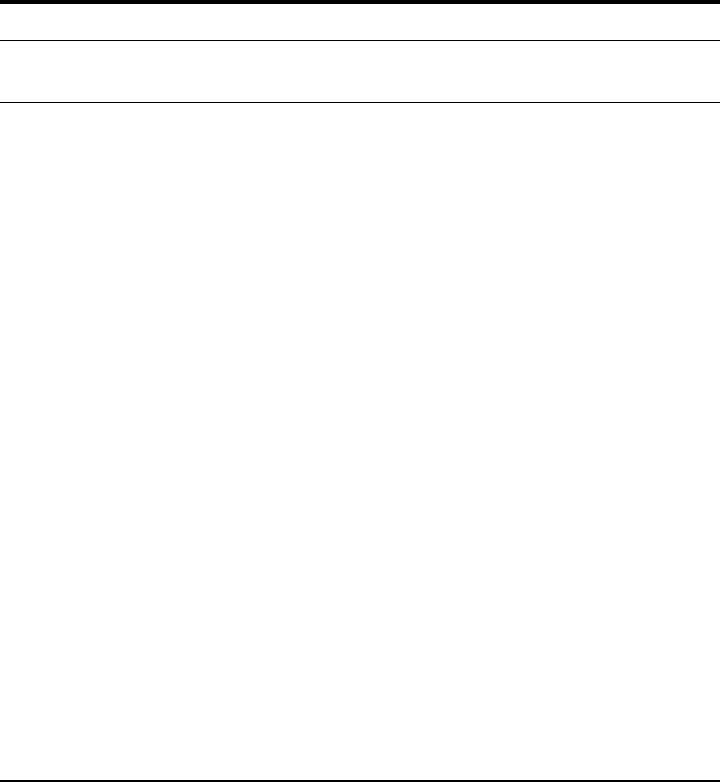
11.2.4 Refer to Exercise 9.7.2, which describes research by Reiss et al. (A-5), who collected samples from
90 patients and measured partial thromboplastin time (aPTT) using two different methods: the
CoaguChek point-of-care assay and standard laboratory hospital assay. The subjects were also classi-
fied by their medication status: 30 receiving heparin alone, 30 receiving heparin with warfarin, and
30 receiving warfarin and enoxaparin. The data are as follows.
Heparin Warfarin Warfarin and Enoxaparin
CoaguChek Hospital CoaguChek Hospital CoaguChek Hospital
aPTT aPTT aPTT aPTT aPTT aPTT
49.3 71.4 18.0 77.0 56.5 46.5
57.9 86.4 31.2 62.2 50.7 34.9
59.0 75.6 58.7 53.2 37.3 28.0
77.3 54.5 75.2 53.0 64.8 52.3
42.3 57.7 18.0 45.7 41.2 37.5
44.3 59.5 82.6 81.1 90.1 47.1
90.0 77.2 29.6 40.9 23.1 27.1
55.4 63.3 82.9 75.4 53.2 40.6
20.3 27.6 58.7 55.7 27.3 37.8
28.7 52.6 64.8 54.0 67.5 50.4
64.3 101.6 37.9 79.4 33.6 34.2
90.4 89.4 81.2 62.5 45.1 34.8
64.3 66.2 18.0 36.5 56.2 44.2
89.8 69.8 38.8 32.8 26.0 28.2
74.7 91.3 95.4 68.9 67.8 46.3
150.0 118.8 53.7 71.3 40.7 41.0
32.4 30.9 128.3 111.1 36.2 35.7
20.9 65.2 60.5 80.5 60.8 47.2
89.5 77.9 150.0 150.0 30.2 39.7
44.7 91.5 38.5 46.5 18.0 31.3
61.0 90.5 58.9 89.1 55.6 53.0
36.4 33.6 112.8 66.7 18.0 27.4
52.9 88.0 26.7 29.5 18.0 35.7
57.5 69.9 49.7 47.8 78.3 62.0
39.1 41.0 85.6 63.3 75.3 36.7
74.8 81.7 68.8 43.5 73.2 85.3
32.5 33.3 18.0 54.0 42.0 38.3
125.7 142.9 92.6 100.5 49.3 39.8
77.1 98.2 46.2 52.4 22.8 42.3
143.8 108.3 60.5 93.7 35.8 36.0
Source: Curtis E. Haas, Pharm.D. Used with permission.
Use the multiple regression to predict the hospital aPTT from the CoaguCheck aPTT level as well
as the medication received. Is knowledge of medication useful in the prediction? Let for
all tests.
a = .05
EXERCISES 555

11.3 VARIABLE SELECTION PROCEDURES
Health sciences researchers contemplating the use of multiple regression analysis to solve
problems usually find that they have a large number of variables from which to select
the independent variables to be employed as predictors of the dependent variable. Such
investigators will want to include in their model as many variables as possible in order
to maximize the model’s predictive ability. The investigator must realize, however, that
adding another independent variable to a set of independent variables always increases
the coefficient of determination Therefore, independent variables should not be added
to the model indiscriminately, but only for good reason. In most situations, for example,
some potential predictor variables are more expensive than others in terms of data-
collection costs. The cost-conscious investigator, therefore, will not want to include an
expensive variable in a model unless there is evidence that it makes a worthwhile
contribution to the predictive ability of the model.
The investigator who wishes to use multiple regression analysis most effectively
must be able to employ some strategy for making intelligent selections from among
those potential predictor variables that are available. Many such strategies are in cur-
rent use, and each has its proponents. The strategies vary in terms of complexity and
the tedium involved in their employment. Unfortunately, the strategies do not always
lead to the same solution when applied to the same problem.
Stepwise Regression Perhaps the most widely used strategy for selecting inde-
pendent variables for a multiple regression model is the stepwise procedure. The proce-
dure consists of a series of steps. At each step of the procedure each variable then in the
model is evaluated to see if, according to specified criteria, it should remain in the model.
Suppose, for example, that we wish to perform stepwise regression for a model
containing k predictor variables. The criterion measure is computed for each variable. Of
all the variables that do not satisfy the criterion for inclusion in the model, the one that
least satisfies the criterion is removed from the model. If a variable is removed in this
step, the regression equation for the smaller model is calculated and the criterion meas-
ure is computed for each variable now in the model. If any of these variables fail to sat-
isfy the criterion for inclusion in the model, the one that least satisfies the criterion is
removed. If a variable is removed at this step, the variable that was removed in the first
step is reentered into the model, and the evaluation procedure is continued. This process
continues until no more variables can be entered or removed.
The nature of the stepwise procedure is such that, although a variable may be
deleted from the model in one step, it is evaluated for possible reentry into the model in
subsequent steps.
MINITAB’s STEPWISE procedure, for example, uses the associated F statistic as
the evaluative criterion for deciding whether a variable should be deleted or added to
the model. Unless otherwise specified, the cutoff value is The printout of the
STEPWISE results contains t statistics (the square root of F ) rather than F statistics.
At each step MINITAB calculates an F statistic for each variable then in the model. If
the F statistic for any of these variables is less than the specified cutoff value (4 if some
other value is not specified), the variable with the smallest F is removed from the model.
The regression equation is refitted for the reduced model, the results are printed, and
F = 4.
R
2
.
556 CHAPTER 11 REGRESSION ANALYSIS: SOME ADDITIONAL TECHNIQUES
